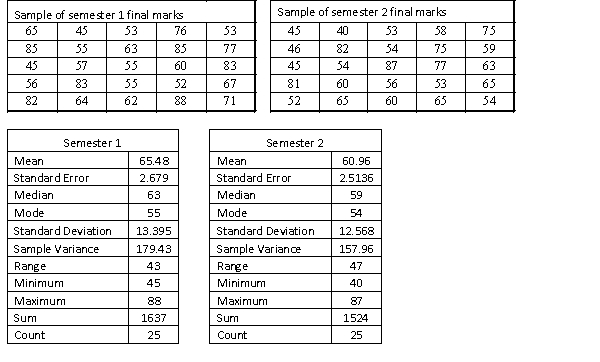A statistics course at a large university is taught in each semester. A student has noticed that the students in semester 1 and semester 2 are enrolled in different degrees. To investigate, the student takes a random sample of 25 students from semester 1 and 25 students from semester 2 and records their final marks (%) provided in the table below. Excel was used to generate descriptive statistics on each sample.
Assume that student final marks are normally distributed in each semester.  (a) Can we conclude at the 5% level of significance that semester 1 students have a higher proportion of high distinctions than semester 2 students, where a high distinction is a final mark greater than or equal to 85%?
(a) Can we conclude at the 5% level of significance that semester 1 students have a higher proportion of high distinctions than semester 2 students, where a high distinction is a final mark greater than or equal to 85%?
(b) Find the p-value of the test, and explain how to use it to test the hypotheses.
Definitions:
Shortage Costs
The costs incurred when demand exceeds supply, including lost sales, expedited shipping fees, and decreased customer satisfaction.
Disrupted Production
Interruptions in the normal flow of manufacturing processes due to unforeseen events, leading to delays and potential financial losses.
Lost Sales
The potential revenue that a company misses out on due to being out of stock, having insufficient capacity, or other reasons for not fulfilling customer demand.
Quantity Discounts
Price reductions applied to bulk purchases, incentivizing buyers to increase the volume of their purchase.
Q21: The standard error of the estimate is
Q22: The Kruskal-Wallis test can be used to
Q26: The Bretton Woods system collapsed because:<br>A)the world
Q55: The sampling distribution of the random variable
Q63: The World Bank estimates GNI per capita
Q64: Countries that are technologically backward can grow
Q65: Which of the following groups of countries
Q85: Use the 5% significance level to
Q109: Improvement in the quality of human capital
Q144: A stable macroeconomic environment and reliable financial